Content
Published:
Updated:
This is an archived release.
Reduced energy consumption in Norwegian economy
Norwegian companies consumed less energy in their production of goods and services in 2014 compared to 2013. Compared with 2000, there was a small increase in the energy consumption of less than 1 per cent. During the same period, however, production in the Norwegian economy has increased significantly, such that energy intensity has decreased by 23 per cent since the millennium.
| All energy products | Per cent change | ||||
|---|---|---|---|---|---|
| 2000 | 2013 | 2014 | 2000-2014 | 2013 - 2014 | |
| 11 Except energy products used for non-energy purposes, conversion in refineries and households. | |||||
| Norwegian primary production | 2 534 | 2 191 | 2 210 | -12.8 | 0.9 |
| Imports | 65 | 96 | 76 | 16.9 | -20.8 |
| Exports | 2 290 | 2 014 | 2 042 | -10.8 | 1.4 |
| Energy use | |||||
| All industries1 | 253 | 258 | 255 | 0.8 | -1.1 |
| Oil and gas extraction | 41 | 53 | 56 | 37.1 | 5 |
| Manufacturing | 89 | 76 | 76 | -15.1 | -1.2 |
| Transport | 76 | 65 | 65 | -14.7 | -1 |
| Energy intensity (GWh / NOK billion) | |||||
| All industries1 | 90 | 70 | 69 | -23.3 | -1.4 |
| Oil and gas extraction | 88 | 140 | 146 | 65.9 | 4.3 |
| Manufacturing | 179 | 123 | 121 | -32.4 | -1.6 |
| Transport | 310 | 234 | 224 | -27.7 | -4.3 |
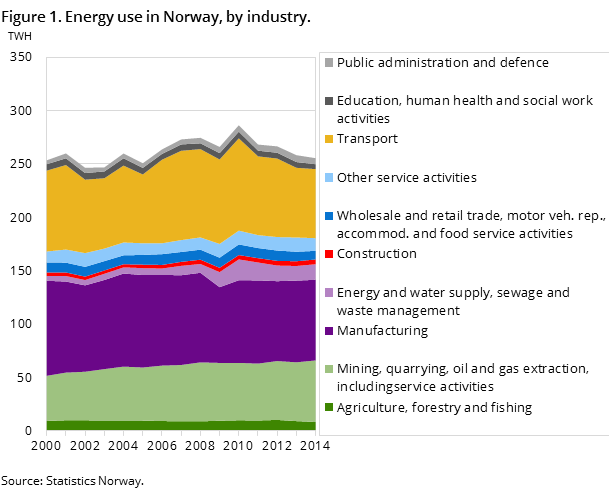
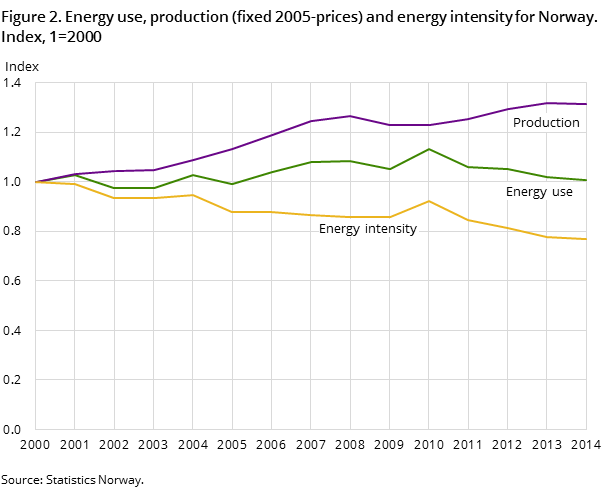
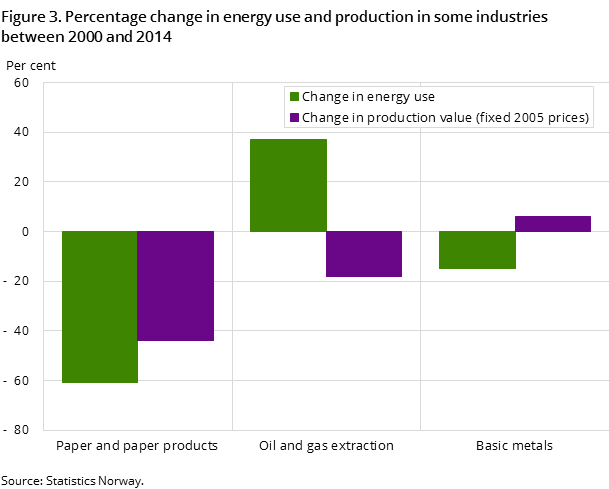
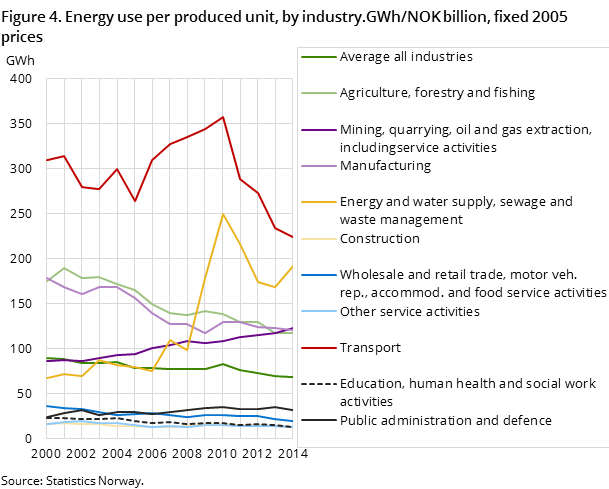
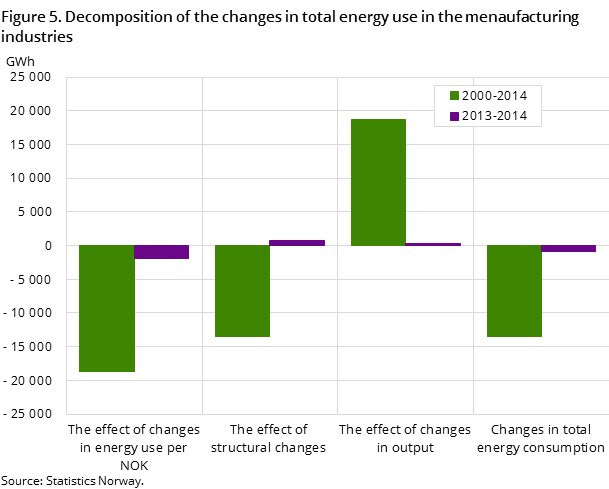
In previous years, figures for the energy balance and the energy account were published in one article. In order to better highlight the developments in these two different ways of displaying the energy production and consumption, analyses of the figures are now published in two different articles. In this article, the energy accounts including energy intensities are published. Figures for 2014 are preliminary figures. Figures for the production and consumption of energy on Norwegian territory are presented in the energy balance.
Weak growth in the primary energy production
According to the energy account, the total primary energy production in 2014 was 2210 TWh, which is a 1 per cent increase from the previous year. Thirty-nine per cent of this total production was crude oil, 48 per cent natural gas and 6 per cent was district heating and electricity. Net energy exports, i.e. exports minus imports, was 1966 TWh.
Total energy use almost unchanged in 2014
Total energy use by Norwegian companies was 255 TWh in 2014, which is a 1 per cent change from the previous year. This does not include energy products used as raw materials or transformation in the manufacturing industries or the refineries. In addition, the energy consumption in households was 61 TWh
Changes in energy consumption influenced by different factors
The development in energy use is influenced by numerous factors. Increased production of goods and services contribute in isolation to higher energy consumption, while technological development of more energy-efficient products and a focus on energy efficiency will contribute to lower energy use. The composition of businesses in the economy also has a large bearing on the development of energy for the economy as a whole, where structural changes, such as the growth in energy-intensive industries, contribute to increased energy use.
By calculating energy intensities, we can ascertain whether the production has become more or less energy-intensive over time.
Reduced energy intensity in the Norwegian economy
By looking at energy consumption in relation to production of goods and services by Norwegian companies, we obtain a measure of energy intensity. In 2014, Norwegian companies used 69 GWh per billion NOK produced (measured in fixed 2005 prices). This is a reduction of just over 1 per cent from the previous year and 23 per cent lower than in 2000. However, looking at the individual industries, the trend has been quite different in the 2000s.
Energy consumption in manufacturing industries down while production has increased
The energy use in the manufacturing industries was 76 TWh in 2014, which is a decrease of 1 per cent from 2014 and 15 per cent from 2000. While energy consumption has decreased, the production in manufacturing increased. It has resulted in a decline in the energy intensity of more than 30 per cent from 2000. Energy intensity averaged 121 GWh per billion NOK in 2014 for the manufacturing industries.
The decline in energy consumption since 2000 has been particularly large in the energy-intensive industries such as metals and production of paper and paper products. Energy use in the production of basic metals was 31 TWh in 2014, which is 15 per cent lower than in 2000. The production of basic metal increased slightly in this period, resulting in a decrease in energy intensity of 20 per cent.
In the production of paper and paper products, 4.5 TWh was used in 2014, which is a decline of 60 per cent from 2000. Closures of paper mills and lower production partly explain the reduced energy consumption in the production of paper and paper products. In addition, energy intensity decreased by 30 per cent during this period, meaning that less energy is used per unit produced.
Significant increase in energy use in oil and gas extraction
Energy use in oil and gas extraction has increased by 5 per cent from 2013 and 37 per cent since 2000 to 56 TWh in 2014. In the same period, production has fallen, giving an increase in energy intensity of 66 per cent. The correlation between oil and gas extraction and energy consumption is complex. The energy intensity varies among the different oil and gas fields. One reason for the increased average energy intensity in oil and gas extraction is considered to be related to more energy-demanding production as the most easily accessible oil and gas resources extracted.
Primary and transportation industries use less energy
Energy use in the primary industries of agriculture, forestry and fishing reached 8.5 TWh in 2014, which is a decline of 10 per cent from 2000. Energy consumption in the transport industries, including ocean transport and international air transport, was 65 TWh, which is 15 per cent lower than in 2000. During the same period, energy intensity decreased by 33 per cent for agriculture, forestry and fishing and 28 per cent for the transport industries.
Warm weather in 2014 resulted in lower energy consumption for households
Record high temperatures in 2014 contributed to a decline in energy consumption in households of about 5 per cent from the year before. Compared to 2000, there has been an increase of about 3 per cent, which is significantly lower than the population and consumption growth in the same period.
What determines changes in energy consumption?Open and readClose
The change in energy use is due to several factors. Increased economic activity is the main cause of higher energy use, but changes in industry structure and how efficiently energy is used also affect the size of energy consumption. Statistics Norway has analysed the reasons behind the development in total energy consumption in manufacturing and for detailed manufacturing industries based on the change in three factors:
•How efficient manufacturing groups utilise the energy in production (energy efficiency)
•Manufacturing groups’ share of total production value (industry structure)
•Total production value from manufacturing (activity)
The development from 2012 to 2013 is described in the Norwegian article on more effective energy consumption in 2013 (Mer effektiv energiutnyttelse i 2013), while developments for the period 2003-2012 are described in the Norwegian article on increased manufacturing production with less energy (Økt industriproduksjon med mindre energi).
The results of these analyses for different time periods are now available in Statbank (see Statbank Table 10908).
Better utilization in Norwegian manufacturing industries Open and readClose
Decomposition analysis can be used to better understand the reasons for the changes in energy consumption. Decomposition analysis has been undertaken for the manufacturing industries in Norway.
Total energy consumption in the manufacturing industries dropped by 1.2 per cent in 2014. Output in Norwegian manufacturing increased by 1.2 per cent the same year (measured in fixed prices). The increased production in the manufacturing industries in isolation would have resulted in an increase in energy consumption of just 0.4 per cent in 2014. There has also been a relative shift of production between the different manufacturing industries (restructuring), which collectively pulled energy use up by a total of 1 per cent. Nevertheless, total energy consumption in the manufacturing industries dropped..This is primarily due to the utilisation of energy becoming more efficient in 2014. In isolation, the utilisation of energy becoming more efficient would have resulted in a total drop in the energy consumption of 2.5 per cent.
The situation in 2014 is somewhat different from previous years since the restructuring of the manufacturing industries pulled energy consumption up and not down. For the period 2000-2014, production in Norwegian manufacturing increased by 14 per cent and energy use fell by 25 per cent. The main reason for the decline in energy consumption has been that energy has been utilised more effectively in addition to changes in the industry restructuring resulting from the energy-intensive manufacturing industries with the largest energy consumption having a smaller share of the total industrial output in 2014 than in 2000.
Difference between energy accounts and energy balancesOpen and readClose
The energy accounts and the energy balances are based on more or less the same figures, but are presented according to different principles and definitions. The energy accounts follow the definitions in the national accounts and the energy balance comprises the energy consumption on Norwegian territory. The figures for the energy accounts and the energy balances therefore give different figures for energy consumption. For more details, see About the statistics.
The statistics is now published as Production and consumption of energy, energy balance and energy account.
Contact
-
Statistics Norway's Information Centre
E-mail: informasjon@ssb.no
tel.: (+47) 21 09 46 42
